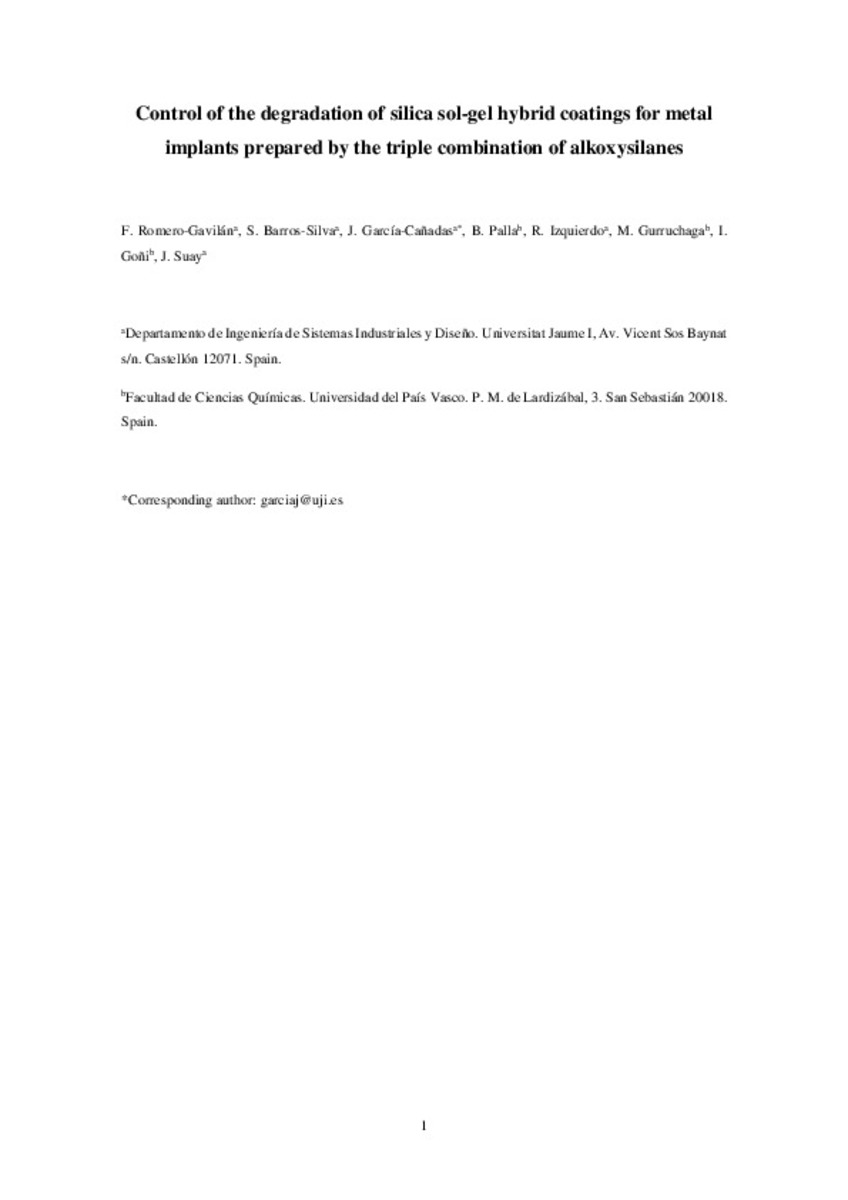Mostrar el registro sencillo del ítem
Control of the degradation of silica sol-gel hybrid coatings for metal implants prepared by the triple combination of alkoxysilanes
| dc.contributor.author | Romero-Gavilán, Francisco J | |
| dc.contributor.author | Barros Silva, S. | |
| dc.contributor.author | García-Cañadas, Jorge | |
| dc.contributor.author | Palla, B. | |
| dc.contributor.author | Izquierdo Escrig, Raul | |
| dc.contributor.author | GURRUCHAGA, MARILO | |
| dc.contributor.author | Goñi, Isabel | |
| dc.contributor.author | Suay, Julio | |
| dc.date.accessioned | 2016-11-07T16:46:29Z | |
| dc.date.available | 2016-11-07T16:46:29Z | |
| dc.date.issued | 2016 | |
| dc.identifier.citation | ROMERO-GAVILÁN, F., et al. Control of the degradation of silica sol-gel hybrid coatings for metal implants prepared by the triple combination of alkoxysilanes. Journal of Non-Crystalline Solids, 2016, vol. 453, p. 66-73. | ca_CA |
| dc.identifier.issn | 0022-3093 | |
| dc.identifier.issn | 1873-4812 | |
| dc.identifier.uri | http://hdl.handle.net/10234/164128 | |
| dc.description.abstract | Hybrid materials obtained by sol-gel process are able to degrade and release Si compounds that are useful in regenerative medicine due to their osteoinductive properties. The present work studies the behavior of new organic-inorganic sol-gel coatings based on triple mixtures of alkoxysilanes in different molar ratios. The precursors employed are methyl-trimethoxysilane (MTMOS), 3-glycidoxypropyl-trimethoxysilane (GPTMS) and tetraethyl-orthosilicate (TEOS). After optimization of the synthesis conditions, the coatings were characterized using 29Si nuclear magnetic resonance (29Si-MNR), Fourier transform infrared spectrometry (FT-IR), contact angle measurements, hydrolytic degradation assays, electrochemical impedance spectroscopy (EIS) and mechanical profilometry. The degradation and EIS results show that by controlling the amount of TEOS precursor in the coating it is possible to tune its degradation by hydrolysis, while keeping properties such as wettability at their optimum values for biomaterials application. The corrosion properties of the new coatings were also evaluated when applied to stainless steel substrate. The coatings showed an improvement of the anticorrosive properties of the steel which is important to protect the metal implants at the early stages of the regeneration process. | ca_CA |
| dc.description.sponsorShip | The financial support of MAT2014-51918-C2-2-R, P11B2014-19 and Plan de Promoción de la Investigación from the Universitat Jaume I (Predoc/2014/25) is gratefully acknowledged. J. García-Cañadas acknowledge financial support from Ramón y Cajal programme (RYC-2013-13970). The experimental support of Raquel Oliver Valls and José Ortega Herreros is also acknowledged. | ca_CA |
| dc.format.extent | 21 p. | ca_CA |
| dc.format.mimetype | application/pdf | ca_CA |
| dc.language.iso | eng | ca_CA |
| dc.publisher | Elsevier | ca_CA |
| dc.relation.isPartOf | Journal of Non-Crystalline Solids, 2016, vol. 453 | ca_CA |
| dc.rights.uri | http://rightsstatements.org/vocab/CNE/1.0/ | * |
| dc.subject | Si release | ca_CA |
| dc.subject | Corrosion resistance | ca_CA |
| dc.subject | TEOS | ca_CA |
| dc.subject | Biomaterials | ca_CA |
| dc.subject | Coatings | ca_CA |
| dc.title | Control of the degradation of silica sol-gel hybrid coatings for metal implants prepared by the triple combination of alkoxysilanes | ca_CA |
| dc.type | info:eu-repo/semantics/article | ca_CA |
| dc.identifier.doi | http://dx.doi.org/10.1016/j.jnoncrysol.2016.09.026 | |
| dc.rights.accessRights | info:eu-repo/semantics/openAccess | ca_CA |
| dc.relation.publisherVersion | http://www.sciencedirect.com/science/article/pii/S0022309316304112 | ca_CA |
Ficheros en el ítem
Este ítem aparece en la(s) siguiente(s) colección(ones)
-
ESID_Articles [472]







